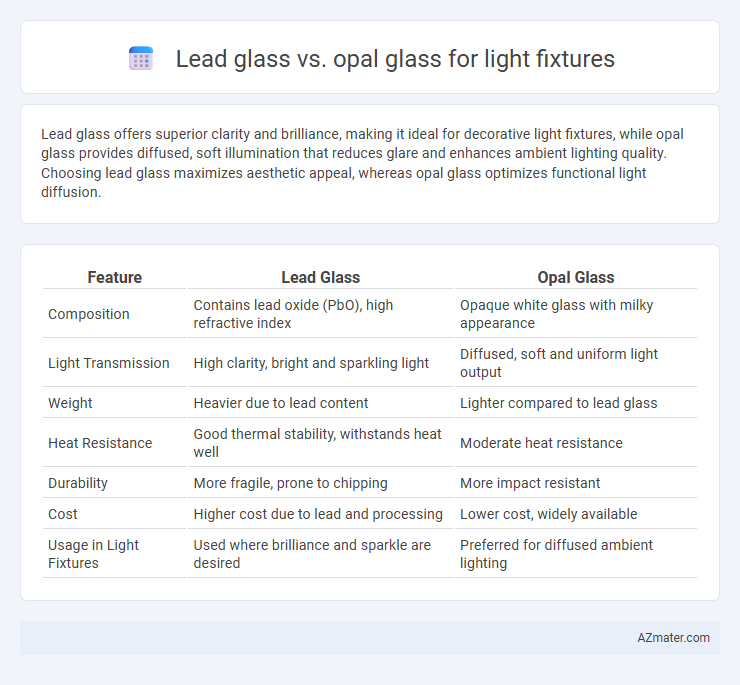Lead glass offers superior clarity and brilliance, making it ideal for decorative light fixtures, while opal glass provides diffused, soft illumination that reduces glare and enhances ambient lighting quality. Choosing lead glass maximizes aesthetic appeal, whereas opal glass optimizes functional light diffusion.
Table of Comparison
| Feature | Lead Glass | Opal Glass |
|---|---|---|
| Composition | Contains lead oxide (PbO), high refractive index | Opaque white glass with milky appearance |
| Light Transmission | High clarity, bright and sparkling light | Diffused, soft and uniform light output |
| Weight | Heavier due to lead content | Lighter compared to lead glass |
| Heat Resistance | Good thermal stability, withstands heat well | Moderate heat resistance |
| Durability | More fragile, prone to chipping | More impact resistant |
| Cost | Higher cost due to lead and processing | Lower cost, widely available |
| Usage in Light Fixtures | Used where brilliance and sparkle are desired | Preferred for diffused ambient lighting |
Introduction to Glass Types in Light Fixtures
Lead glass contains lead oxide, enhancing its refractive index and brilliance, making it ideal for decorative light fixtures requiring high clarity and sparkle. Opal glass, characterized by its milky, translucent appearance, diffuses light softly, providing uniform illumination and reducing glare in lighting applications. Both glass types serve distinct functional and aesthetic purposes in light fixtures, with lead glass focusing on ornate brilliance and opal glass prioritizing diffuse, ambient lighting.
What is Lead Glass?
Lead glass, also known as lead crystal, is a type of glass that contains lead oxide, typically between 18% to 40%, which enhances its refractive index and brilliance, making it ideal for decorative light fixtures. It offers superior clarity and weight compared to opal glass, contributing to a luxurious appearance and effective light diffusion. Lead glass's high density and ability to refract light create sparkling visual effects, distinguishing it from the milky, diffuse glow characteristic of opal glass.
What is Opal Glass?
Opal glass is a type of translucent glass created by adding white, opacifying materials like fluorides or phosphates to molten glass, resulting in a milky, diffused appearance that softens light output. Unlike lead glass, which contains lead oxide for higher refractive index and brilliance, opal glass prioritizes uniform light diffusion and glare reduction, making it ideal for light fixture covers and diffusers. Its smooth, non-reflective surface enhances ambient lighting quality while maintaining durability and resistance to yellowing over time.
Visual Aesthetics: Lead vs Opal Glass
Lead glass offers exceptional clarity and brilliance in light fixtures, enhancing the visual appeal with its high refractive index that creates sparkling light effects. Opal glass provides a soft, diffused glow that evenly distributes light, reducing glare and creating a warm, ambient atmosphere. The choice between lead and opal glass depends on whether a fixture requires dazzling brilliance or subtle, uniform illumination for optimal visual aesthetics.
Light Diffusion and Brightness Comparison
Lead glass offers superior light diffusion due to its higher refractive index, creating a brighter and more sparkling illumination in light fixtures. Opal glass provides a softer, more uniform light with reduced glare, ideal for diffusing light evenly but resulting in lower brightness levels. The choice depends on whether enhanced brilliance (lead glass) or gentle, consistent lighting (opal glass) is prioritized in the fixture design.
Durability and Maintenance Differences
Lead glass offers enhanced durability due to its higher density and resistance to cracking, making it suitable for long-lasting light fixtures. Opal glass, while aesthetically pleasing with its matte finish, is more prone to surface scratches and requires careful handling during maintenance. Cleaning lead glass typically involves gentle polishing to maintain clarity, whereas opal glass demands frequent dusting to prevent dullness and maintain light diffusion quality.
Safety and Environmental Considerations
Lead glass in light fixtures contains lead oxide, enhancing clarity but posing health risks if broken, requiring careful disposal to prevent lead contamination. Opal glass is lead-free, offering safer handling and greater environmental friendliness due to easier recycling and absence of toxic substances. Choosing opal glass improves indoor air quality and reduces hazardous waste, supporting sustainable lighting solutions.
Cost Analysis: Lead Glass vs Opal Glass
Lead glass typically incurs higher manufacturing costs due to its increased density and the presence of lead oxide, which enhances brilliance and weight, making it ideal for premium light fixtures. Opal glass, composed primarily of silica and alkaline earth metals, offers a more cost-effective solution with lower material expenses and simpler production processes, leading to reduced overall fixture costs. When evaluating cost analysis, opal glass often provides better budget efficiency for bulk lighting projects, whereas lead glass justifies its higher price through superior optical clarity and decorative appeal.
Best Applications for Each Glass Type
Lead glass offers high refractive index and exceptional clarity, making it ideal for decorative light fixtures where sparkle and brilliance enhance visual appeal, such as chandeliers and elegant pendant lights. Opal glass provides a diffused, soft white light that reduces glare and shadows, making it the best choice for functional lighting in residential spaces, offices, and medical facilities. Both glass types cater to distinct lighting needs: lead glass prioritizes aesthetics and light refraction, while opal glass focuses on uniform illumination and eye comfort.
Which Glass is Right for Your Light Fixture?
Lead glass offers superior clarity and exceptional light refraction, making it ideal for fixtures where brilliance and sparkle are desired. Opal glass diffuses light evenly, creating a soft, glare-free ambiance perfect for ambient or task lighting. The right choice depends on whether you prioritize aesthetic brilliance with lead glass or gentle, uniform illumination with opal glass.

Infographic: Lead glass vs Opal glass for Light fixture
 azmater.com
azmater.com